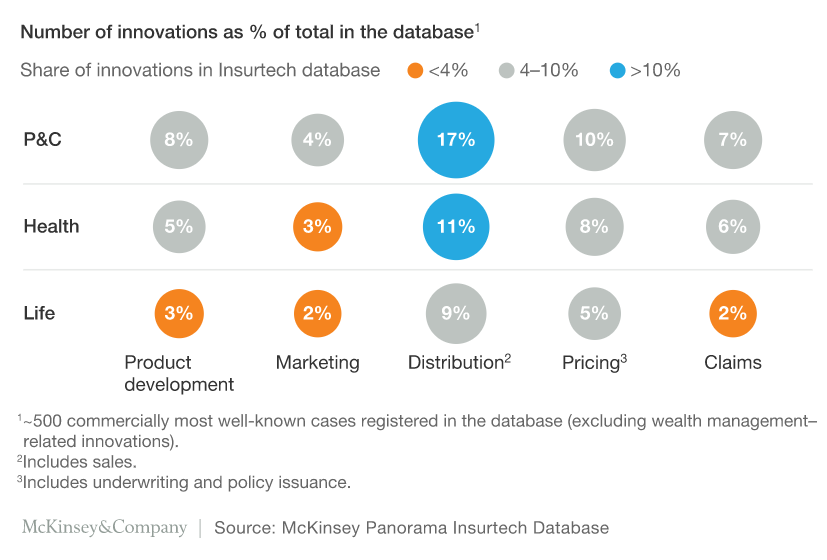
The rise and role of Insurtech – the industry’s approach to innovation
The insurance industry is considered – compared to most other industries – to be a conservative one.
From the perspective of the customer, not much has changed in the last few decades. From the perspective of insurance companies, there have been investments in core system renewals, CRM, sales forces and customer portals, but:
- The success of many such projects left a lot be desired.
- The focus was mostly on improving operational efficiency.
As a step towards improving client engagement levels, client portals have been introduced during the past decade. They offer policy conclusion or renewal for a limited number of products, asset overview and management overview for life policies, claim notification, and online payments. I have to admit to forgetting the password to my insurance company portal almost every time I remember to take a look at it. There is nothing wrong with the portal itself, it is just that I do not use it very often.
The insurance business has two socio-psychological components that play a significant role here:
- Insurance itself has a slightly negative connotation – you spend money to prevent the loss of more money/health. It plays an important role in ensuring a stable society, but still, there is no gratification there for the customer, just plain rationality.
- Customer engagements are few and far between – if there’s no claim, the insurance company only engages with its client on a yearly basis.
Therefore, focusing on operational efficiency rather than on customer experience previously made a lot of sense for insurance companies.
The arrival of 'Insurtechs'
The term 'Insurtech' encompasses the trends, products and companies that promise to disrupt or change existing business practices in the insurance industry through technological advances and a customer-centric approach. The digitalisation movement in the insurance industry started in 2012, when the first start-ups appeared, offering predominantly advances in sales and digitisation of existing business models.
According to Mckinsey, insurtech is active in all major insurance products and business lines, with concentrations in the P&C business and in the marketing and distribution areas of the value chain.

In 2018, over $3 billion was invested in insurtech companies, with approximately one third of investments going into European companies. According to Statista, most Insurtech companies wish to collaborate with traditional insurance companies, rather than disrupt the industry. This means that there is a symbiosis between them.
Cooperation with insurtech companies is “en vogue“
With the appearance of the insurtech movement, most of the innovations came from companies outside the insurance industry. Why? Because innovations are coming in the form of new technologies being used for various business use cases. Since the introduction of Cobol-based software in banks and insurance companies, insurance companies have gradually decreased the size of their IT departments, limiting them to supporting roles with not much scope for research and development.
Insurance companies have recognised the value and ideas that insurtech is trying to bring to the industry. Some insurance companies have partnered with startups, some are funding them, while others are establishing their own startup companies. Almost all have established CDO offices to manage these initiatives.
According to the Celent Insurance in Europe: 2019 Business and IT Priorities report it might still be a little too soon to determine the role of insurtech:
”Our survey shows that 10% of insurers in our sample who have worked with insurtech startups have found good value from this relationship. A further 57% of insurers believe that some insurtech startups can add value. For 23% of our respondents, who have worked with insurtech firms, value is perceived to be rather small. Overall, we think it is still early to identify the value that can be generated. However, these results suggest that European CIOs expect value from insurtech, but for some expectations are higher than results.”
As expected, most of the focus of insurtech was – at least in the beginning – on the simplification of customer engagement. It was geared towards digital carriers with specialised insurance products and highly customised customer journeys. Also, there was a social component – peer to peer insurance - played an important role in the early stages of the insurtech boom. One could argue that none of the ideas really caught on, nor were they a massive business success.
From the initial customer engagement focus, the trend moved towards leveraging advanced technologies and Artificial Intelligence to improve operational efficiency. Here, once again, the initiative came from the outside.
Although the solutions may address only a part of the value chain and are not very interesting for the general population, they may well have a much brighter future. Some examples include automated claim evaluation and handling based on photographic or video recognition, automated underwriting based on predictive analytics, automated cross-selling etc. Some of these ideas have already found a place in the production operations of selected insurance companies. Although currently, they are still limited in scale, through evolution these technologies will, in 3 to 5 years, gradually automate most back-office business processes. The only limiting factor may be the ability of the core system to keep pace with the advancements of peripheral solutions – an insurance company needs an open, expandable platform with a comprehensive integration layer and strong workflow support to successfully automate the whole process.
The future
I believe that achieving operational excellency through the evolution and application of technology is just a matter of time. Current IT spending proves that – while expenditure on digital portals is decreasing, investment in master data management, data analytics and AI is increasing – the focus is on mitigating fraud, enhanced underwriting, or the optimisation of customer data capture and analysis.
However, to make a significant advance in the field of customer engagement, insurance would have to become a commodity, cheap enough to buy without a second thought with the click of a button on your smartphone, to simply insure a Wednesday afternoon bike ride, a photo-shoot at the seaside, or a summer hiking trip into the mountains. Alternative product structures – pay-per-use, micro, short term insurance, automatic coverage driven through telematics – could provide the basis for such a leap.
Everybody wants to increase customer engagement, and most insurtech startups provide some way of getting closer to the end user. However, buying insurance is not really consumerism – it happens with a very low frequency, it has a slight negative connotation to it, and it is much more of a necessity than a pleasure. With the development of short-term insurance and micro-insurance, the relationship between the insurance company and the client can become more frequent in nature.





